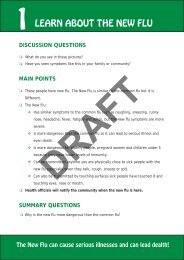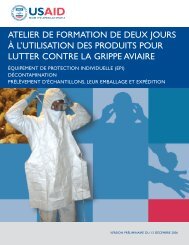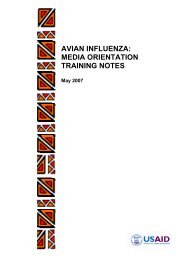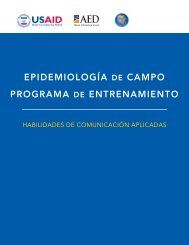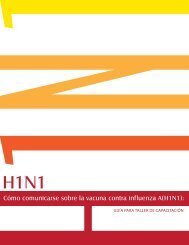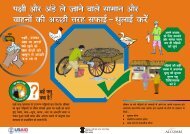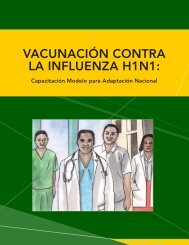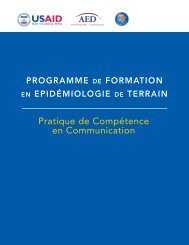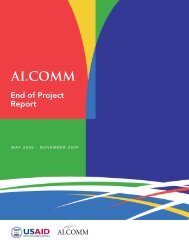Participant Handouts
Participant Handouts
Participant Handouts
Create successful ePaper yourself
Turn your PDF publications into a flip-book with our unique Google optimized e-Paper software.
AVIAN INFLUENZA COMMODITIES<br />
TRAINING GUIDE<br />
MODULE 1 - PERSONAL PROTECTIVE EQUIPMENT (PPE)<br />
PARTICIPANT HANDOUTS<br />
MARCH 2007
MODULE 1<br />
PARTICIPANT HANDOUTS<br />
<strong>Participant</strong> <strong>Handouts</strong><br />
<strong>Participant</strong> Handout #1 – Seven-Step Process for Putting on PPE<br />
<strong>Participant</strong> Handout #2 – Ten-Step Process for Removing and Disposing of<br />
PPE<br />
<strong>Participant</strong> Handout #3 – Proper Hand Washing<br />
<strong>Participant</strong> Handout #4 – Important Facts to Remember when Using the<br />
PPEs Supplied by USAID<br />
<strong>Participant</strong> Handout #5 – Benefits and Barriers to Using PPE<br />
<strong>Participant</strong> Handout #6 – Why Use PPEs<br />
<strong>Participant</strong> Handout #7 – The N-95 Particulate Respirator<br />
<strong>Participant</strong> Handout #8 – Contents of PPE Kit
MODULE 1<br />
Handout #1<br />
Seven-Step Process for Putting on PPE<br />
Before you begin putting on your PPE, it is important to designate a clean location to put<br />
on the equipment, preferably away from anything that could be contaminated with avian<br />
influenza or other viruses. Also try to wash your hands with soap and water – if it is available<br />
– before you begin, and remove watches and other non-smooth jewelry like bracelets.<br />
1. Coveralls<br />
Put on coveralls first. Step into the<br />
“feet” of the coveralls first, and pull<br />
them up. Zip up the front of the<br />
coveralls. You should keep your regular<br />
clothing and shoes on under the<br />
coveralls.<br />
3. Respirators<br />
2. Shoe Covers<br />
Put on shoe covers second. They<br />
should fit over your coverall feet, giving<br />
you another layer of protection to<br />
protect your shoes from contamination.<br />
Put the respirator under your chin<br />
with the nosepiece up. Pull the bottom<br />
strap over your head, and place it<br />
around your neck below the ears.<br />
Then pull the top strap over your head<br />
and rest it high at the top back of<br />
your head. Place your fingertips from<br />
both hands at the top of the metal<br />
nosepiece. Using two hands, mold the<br />
nose area to the shape of your nose<br />
by pushing inward while moving your<br />
fingertips down both sides of the<br />
nosepiece.
5. Apron<br />
Aprons are provided to fit over the<br />
coveralls. They are in a small packet<br />
that you will open up, place the apron<br />
over your head and then tie in the<br />
back.<br />
4. Goggles<br />
Goggles are adjustable and should fit<br />
snuggly over and around your eyes.<br />
If you wear personal eye glasses, the<br />
goggle can be placed over your eye<br />
glasses.
6. Inner Gloves<br />
Put on the inner pair of gloves first<br />
(usually white or clear).<br />
7. Outer Gloves<br />
Will usually be a different color than<br />
the inner gloves and may be thicker.<br />
Pull them over the inner gloves. Pull<br />
the edge of the gloves over the cuff of<br />
your coveralls or gown, if possible.
MODULE 1<br />
Handout #2<br />
Ten-Step Process for Removing and Disposing of PPE<br />
Before you begin the process of removing your PPE, you should find an area that is not<br />
contaminated with blood, soil, feces or other waste.<br />
1. Open the pouch with the germicidal<br />
wipe and use it first on your outer<br />
gloves and then on your outer<br />
boots. Place it in the red biohazard<br />
bag when done.
2. Remove and dispose of your apron<br />
in the red biohazard bag.<br />
4. Remove and dispose of your outer<br />
gloves in the red biohazard bag.<br />
5. Unzip and roll down your coverall<br />
until it is inside-out, and then step<br />
out of it. Place the used coveralls<br />
into the red biohazard bag.<br />
3. Remove and dispose of your outer<br />
shoe covers in the red biohazard<br />
bag.
6. Remove your goggles by pulling<br />
them up over your head. You should<br />
handle them by the headband or<br />
ear pieces. Place them in the red<br />
biohazard bag.<br />
7. Remove your respirator by grabbing<br />
the top and then the bottom elastic<br />
bands and pulling them up over your<br />
head. Place the respirator in the red<br />
biohazard bag.<br />
8. Remove your inside gloves. Begin<br />
with one hand, rolling down the<br />
glove (with your other hand),<br />
starting at the wrist until the glove is<br />
inside out. Hold the removed glove<br />
in your hand in a little ball, and then<br />
roll down the other glove – starting<br />
at the wrist – with your first hand.<br />
Place them in the red biohazard bag.
9. Close the red biohazard bag by tying<br />
a knot at the top or otherwise tying<br />
it shut. The red biohazard bag should<br />
be placed at a designated location<br />
so that it can be collected and<br />
burned or buried.<br />
10. Wash your hands and forearms<br />
with soap and water.
MODULE 1<br />
Handout #3<br />
Proper Hand Washing<br />
How to Wash Your Hands Correctly<br />
• Wet your hands with water and apply soap. Use clean, running water.<br />
• Rub hands together to make a lather and scrub all surfaces.<br />
• Continue rubbing hands for 20 seconds.<br />
• Rinse hands well under running water<br />
• Air dry your hands, or use a towel if you have one.<br />
When to Wash Your Hands While Using PPE<br />
• Before putting on your PPE<br />
• Before putting on your gloves or respirator again after taking a work break<br />
• Before and after changing your respirator<br />
• After taking off your gloves and the rest of your PPE, and placing them in the red<br />
waste bag<br />
• Any other time your ungloved hands have come into contact with potentially<br />
infected animals, equipment or surfaces.
MODULE 1<br />
Handout #4<br />
Important Facts to Remember when Using the PPEs<br />
Supplied by USAID<br />
Wearing PPE<br />
• All of the PPEs supplied in the PPE Kits are disposable and are designed for use one<br />
time only.<br />
• None of the supplied PPEs should be reused or washed for reuse – reuse could result<br />
in infection of you or someone else.<br />
• Do not use, or provide N-95 respirators to others, without instruction on the health<br />
risks associated with them. For example, workers with poor lung function may not be<br />
able to wear these respirators.<br />
• If you can, do a fit test to make sure no particles can get through.<br />
• N-95 respirators should not be hung around your neck when working, always wear<br />
them when working.<br />
• PPEs must be changed immediately if torn or dirty.<br />
• A designated area for putting on PPEs should be identified and all personnel should<br />
use this area to put on their PPEs. This should ideally be in a clean area away from<br />
birds or any other potentially contaminated equipment, such as cages, crates or farm<br />
tools.<br />
• A designated area for removal of PPEs should be identified and all personnel should<br />
use this area to remove their PPEs. This should ideally be located away from the area<br />
that has recently been depopulated and/or decontaminated.<br />
• Workers have said that the use of PPEs can sometimes make the job more difficult to<br />
accomplish because they can be cumbersome, hot, or uncomfortable. However, they<br />
also know that PPEs are necessary to prevent them from becoming infected or from<br />
spreading the virus to other farms or people, especially the people they care most<br />
about.<br />
Disposal<br />
• All PPEs must be removed and discarded before taking breaks. A new set should be<br />
put on after the break.<br />
• Used PPEs must be discarded immediately after use in an approved manner (such as<br />
burying or burning).<br />
• Red plastic bags are provided in the PPE Kits for this purpose. They should be sealed<br />
and disposed of properly. This means following the instructions of the local officials or<br />
person supervising the work on where to place red biohazard bags when they are full.<br />
• The way to dispose of PPE may be different in each situation or location. Local officials<br />
or those supervising the work will likely decide on how best to dispose of used PPE<br />
and other items that have come in contact with the virus.
MODULE 1<br />
Handout #5<br />
Benefits and Barriers to Using PPE<br />
Benefits<br />
• They are effective.<br />
• They help keep the worker safe and healthy<br />
• They protect the workforce—a much needed workforce to help control avian<br />
influenza outbreaks.<br />
• Workers who use them are protecting their families, communities, farms and<br />
businesses. The help protect the economic security of a region.<br />
Barriers<br />
• Difficulty in performing tasks while wearing the equipment; they limit body<br />
movement<br />
• Difficult to communicate: Someone wearing a N-95 respirator is difficult to<br />
understand<br />
• Hard to see/limits visibility: goggles may limit the wearer’s visual field and can fog<br />
up<br />
• Can become hot/uncomfortable to wear; this requires more breaks<br />
• Because they are difficult to take off and put on, personnel are likely to<br />
avoid taking them off during breaks, thus increasing the risk of infection or<br />
contamination of clothing. Workers should be educated on why they have to<br />
change and PPE removal protocols must be enforced<br />
• Recontamination: Wearers may become contaminated as they remove their<br />
equipment unless decontamination and removal protocols are followed carefully.<br />
• Intimidating: When people see workers in PPE it signals a serious problem and<br />
can cause panic which can interfere with worker communication and cooperation.
MODULE 1<br />
Handout #6<br />
Why Use PPEs<br />
• The avian influenza virus can infect a person through their eyes, nose<br />
or mouth. In fact, most cases of human avian influenza infections have resulted<br />
from contact, in some way, with infected poultry or by touching contaminated<br />
surfaces and then touching one’s eyes, nose or mouth. That is why gloves and face<br />
coverings like respirators and goggles are so important.<br />
• The virus can be in the air we breathe. Poultry manure and bedding from<br />
flocks infected with avian influenza virus can contaminate dust and soil. When<br />
the dust and soil is kicked up by wind, walking or movement, the contaminated<br />
dust can be inhaled through the nose and mouth. That is why wearing the N-95<br />
respirator is important for your safety and well-being.<br />
• The virus can be carried to other farms. Hands/skin, clothing or shoes can<br />
become contaminated with avian influenza virus – either from poultry directly<br />
or from manure/bedding – and then carried to uninfected farms, thus spreading<br />
the virus to new areas. The PPE not only will protect the person wearing it, but it<br />
protects the people and farms he will come into contact with in the near future.<br />
• The virus can survive in the environment. The virus can live in the<br />
environment – outside an infected host. It can survive, at cool temperatures, in<br />
contaminated manure for at least three months. In water, the virus can survive<br />
for up to four days at 22o C and more than 30 days at 0o C. Even if it seems<br />
dramatic, we always have to assume that there is virus in the manure, bedding,<br />
dirt, feathers, and dust or chicken parts. Assuming the worst situation can<br />
motivate us to wear PPE for all jobs, every time.<br />
• It only takes a gram to infect 1 million birds. In studies with avian<br />
influenza a single gram of contaminated manure was found to contain enough<br />
virus to infect 1 million birds. A gram is only about the size of a paper clip or nail.<br />
A single worker with contaminated dirt or manure on his shoes or boots could<br />
cause a huge outbreak.
MODULE 1<br />
Handout #7<br />
The N-95 Particulate Respirator<br />
The respirator in your kit is called an N-95 particulate respirator. Here are a few<br />
things to know about your respirators.<br />
• Respirators are designed to fit adults, their use by children is not recommended.<br />
• The use of the N-95 respirators by itself will not fully protect you from acquiring<br />
an avian influenza infection – they must be used in combination with all of the<br />
other PPE items in your kit.<br />
• N-95 respirators must be made to fit each face. An N-95 respirator that has not<br />
been fitted properly can leave unprotected gaps between the respirator and your<br />
face, and these gaps will impair the respirator’s effectiveness.<br />
• Facial hair or unusual facial features make it difficult to fit N-95 respirators properly.<br />
N-95 respirators cannot effectively be worn with beards or unshaven faces.<br />
• The N-95 respirators lose their protective properties and must be changed when<br />
they become wet from saliva or respiratory secretions.<br />
• If a respirator is splashed and becomes wet, it should be changed using strict<br />
hand-washing procedures and gloves.<br />
• The respirators should be discarded and replaced after 4-6 hours of use. The<br />
other PPE can remain on for the duration of your activities.<br />
• Surgical masks are not respirators! Surgical masks are designed to protect patients<br />
from contaminants generated by the person wearing the mask. They filter out<br />
large-size particles in the air but they offer little protection against avian influenza<br />
virus.<br />
• N-95 respirators should not be hung around your neck when working. Always<br />
wear them when working
MODULE 1<br />
Handout #8<br />
Contents of PPE Kit<br />
1 Pair TYVEK COVERALLS<br />
1 Pair BOOT COVERS<br />
2 Pair NITRILE GLOVES<br />
1 PLASTIC APRON [in plastic pouch]<br />
1 N-95 PARTICULATE RESPIRATOR<br />
1 Pair GOGGLES (WITH INDIRECT VENTS)<br />
4 ALCOHOL WIPES<br />
1 PDI SANITARY VIRICIDAL WIPE<br />
1 INFECTIOUS WASTE BAG (RED)
Prepared by the Academy for Educational Development (AED) and Development<br />
Alternatives, Inc. (DAI) for the USAID Avian Influenza Program.



